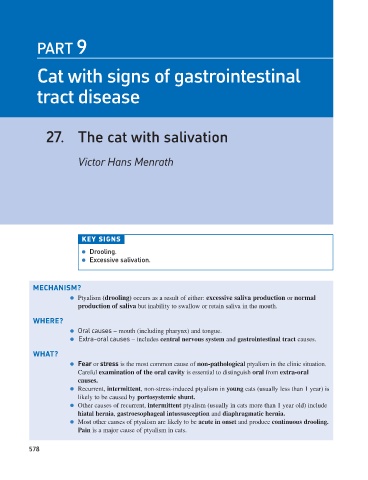Page 586 - Problem-Based Feline Medicine
P. 586
PART 9
Cat with signs of gastrointestinal
tract disease
27. The cat with salivation
Victor Hans Menrath
KEY SIGNS
● Drooling.
● Excessive salivation.
MECHANISM?
● Ptyalism (drooling) occurs as a result of either: excessive saliva production or normal
production of saliva but inability to swallow or retain saliva in the mouth.
WHERE?
● Oral causes – mouth (including pharynx) and tongue.
● Extra-oral causes – includes central nervous system and gastrointestinal tract causes.
WHAT?
● Fear or stress is the most common cause of non-pathological ptyalism in the clinic situation.
Careful examination of the oral cavity is essential to distinguish oral from extra-oral
causes.
● Recurrent, intermittent, non-stress-induced ptyalism in young cats (usually less than 1 year) is
likely to be caused by portosystemic shunt.
● Other causes of recurrent, intermittent ptyalism (usually in cats more than 1 year old) include
hiatal hernia, gastroesophageal intussusception and diaphragmatic hernia.
● Most other causes of ptyalism are likely to be acute in onset and produce continuous drooling.
Pain is a major cause of ptyalism in cats.
578

